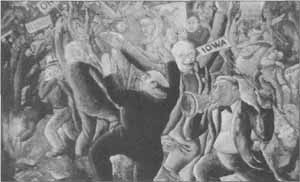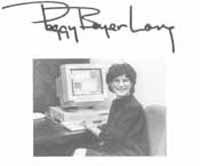EDITOR'S NOTEBOOK
Past conventions provide context for the political present by Peggy Boyer Long Getting a fix on the past isn't easy, but we think it's worth the effort. Illinois is blessed with a rich political history. In fact, Chicago continues to play a central role in the evolving process of presidential selection. There have been 24 national conventions in that city involving both major parties. And this month the Democrats will be back. (The Republicans chose to meet in San Diego.) So, here at Illinois Issues, we've made every effort to help you prepare for the coming political season. In planning this month's magazine, we hoped to give you some sense of the importance of past conventions to our present political life. And we wanted to reflect a bit of the color and pageantry of those events. Mostly, though, we wanted a chance to share what we had discovered. Fortunately, this state is also rich in historical resources. Sometimes it seemed we emptied entire library shelves while tracking down interesting anecdotes and elusive facts. To help us keep the details straight, Associate Editor Beverley Scobell became a temporary reference librarian. She tagged the books with plenty of yellow stickies and stacked them high on her desk. We also managed to tap public and private archives for photographs and illustrations. The Chicago Historical Society was a prime resource, and we owe a special thanks to them for letting us use artist Raymond Katz' painting of the 1932 Democratic convention (see below). It appears on our cover. Franklin Delano Roosevelt overturned tradition at that convention and delivered the first acceptance speech. In Presidential Timber, Herbert Eaton's account of how 32 candidates managed to win their party nominations, he called the address "a dramatic moment, which highlighted the sense of urgency felt throughout the country." Katz' painting manages to capture some of that drama. Meanwhile, our graduate assistant, Brian Lee, was taken by tales of the first young Republicans, the Wide Awakes (see page 7), who helped Abraham Lincoln win his party's nomination in 1860. He spent time foraging through the collection at the Illinois State Historical Library, where he also discovered the pictures of the Republican Wigwam, the site of that nomination (see pages 29 and 33). We owe thanks to the staff at that library, too. They have more than 300,000 photographs in their collection, and we've turned to them countless times. And reporter Jennifer Halperin hit the telephone, and the Internet, to find experts on the state's leaders (see page 6). Indeed, the Internet turned out to be a top source. We were able to download a plot summary of Aida (see page 42) in order to double- check Charlie Wheeler on his comparison of politics to opera. (He was right.) Why go to these lengths? We think such context will help us to understand this summer's events. The past can serve to inform the present.

This photograph of a painting by Raymond Katz came to us courtesy of the Chicago Historical Society 4 ¦ August 1996 Illinois Issues |
||||||||||||||

